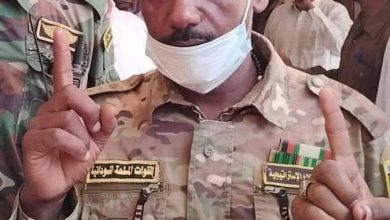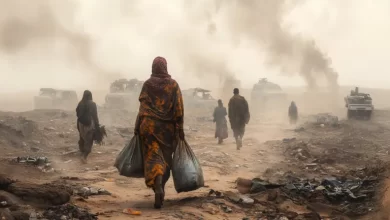Reports
A Mysterious Beast Expands in the Darfur Desert, Shifting the Balance of Military Power… Has the Hour of Resolution Arrived?

Report by Azmi Abdelraziq
Leaning against a burned-out four-wheel-drive vehicle at the recently captured Zarq Operational Base, Commander Munir Hamid of the Desert Axis offers a prayer of gratitude. He has secured new ground and dealt a crushing blow to the militia in a battle described as fierce. This victory disrupts a critical supply chain used to launch attacks on Al-Fashir for nearly a year.
The Road to Darfur
The young commander wasn’t solely focused on the battle as he surveyed the spoils of war and rallied his soldiers with a triumphant cry, “Morale is high!” His mind also wandered back to painful memories: the influx of weapons and mercenaries into his childhood homeland, the displacement of his people, and the fiery devastation of his village during the early days of the conflict. The American director Uwe Boll tried to depict these atrocities in his film “The Road to Darfur,” which portrayed the massacres committed by the Janjaweed in the region over the decades.
On Saturday, social media accounts of armed movement leaders on platforms like X (formerly Twitter) and Facebook shared posts celebrating the Sudanese people’s progress without revealing many details. They also issued fiery statements mirroring the rhetoric of the joint forces, who have been launching assaults on rebellion strongholds in Geneina, Nyala, and Mellit. This follows the liberation of Wadi Howar, Seraf Umra, Bir Mazza, and Merqi—including its military airbase—as well as major sites like Bir Shila, Donki Majoor, Bir Jibril, and Donki Wakhaim, culminating in the capture of Zarq Base (also known as Base “H-M”).
Hands of the Clock Turn Toward Resolution
Jibril Ibrahim, leader of the Sudanese Justice and Equality Movement and Minister of Finance and Economic Planning, congratulated the Sudanese people on Facebook, celebrating the joint forces’ victory over what he called “vile militias” in the Dar esh Shakai battle in North Darfur. He stated, “The militia will not withstand our forces for long after their backbone has been broken and their remnants chased for kilometers. Victory is near, God willing.”
Similarly, Darfur Regional Governor Arko Minawi echoed these sentiments, saying, “We bring good news to our people as the decisive moment approaches. We salute and support our comrades in the joint forces and armed forces in the battlefields of the desert.” He added that they had inflicted unprecedented losses on the Rapid Support Forces (RSF) militia in fierce battles. Minawi hinted at an imminent resolution, noting, “Now, we can say the end is near.”
Journalist Muammar Ibrahim, reporting from Al-Fashir, observed a noticeable shift in the balance of power in favor of the armed forces and joint forces. He documented attacks on rebel-controlled sites around the city’s southern outskirts and shared images of the besieged city, asserting, “It will return safe and secure, God willing, like all our beloved towns.”
This past week, the joint forces engaged in several battles, including one in Dar esh Shakai and Jabal Isa. They destroyed three RSF convoys en route to attack Malha locality. In these operations, the forces seized various weapons and combat vehicles, adding to the spoils from Zarq Base. The RSF sustained significant losses, including the deaths of senior commanders like Ali Yaqoub, Abdel Rahman Shata, Brigadier Khala Jumaa Idris, and, most notably, Taha Madlal, a close associate of Hemedti’s family.
Defections Within the Rebellion
The RSF suffered additional blows due to high-profile defections. Major General Salah Abdelshafi, Inspector General of the Sudan Liberation Movement led by Abdelwahid Mohamed Nour, joined the Sudanese Armed Forces unconditionally. Furthermore, a contingent of RSF soldiers surrendered and aligned with the military in Al-Fashir. Additionally, General Ali Adam Yahya (known as Jamous) defected from forces loyal to Al-Tahir Hajar, aligning instead with the armed forces.
Journalist Muzammil Abu Al-Qasim described Jamous’s defection as a severe blow to the RSF and their ally Al-Tahir Hajar. According to him, Jamous’s troops, previously stationed in South Darfur, moved north to secure areas south of Al-Fashir, including Manwashi, the Al-Fashir-Nyala road, and Abu Zureiga. These developments further tighten the noose on the RSF in North Darfur.
Desert Beast and the Government-in-Exile
Military analysts suggest that the emergence of a highly mobile force—dubbed “the roaming force”—has shifted the military dynamics. This unit, developed by the joint forces, operates with unprecedented agility, launching swift and precise ground assaults on RSF positions in the desert. It disrupts foreign supply chains, destroys logistical hubs, and retreats to prepare for new missions. Experts argue that by crippling the RSF’s logistical depth, the joint forces have achieved “half the victory” in Darfur, leaving the RSF chasing shadows.
The RSF’s operational command has been thrown into disarray, with their strategies compromised both domestically and abroad. The rise of the desert force—unpredictable in its movements and devastating in its attacks—has forced the RSF to withdraw troops from other regions to confront this elusive adversary. The force appears and vanishes like a desert phantom, thwarting attempts to establish a government-in-exile in Darfur. This scenario has left the RSF’s allies grappling with setbacks.
Toward Resolution
With the UAE expressing interest in Turkish-mediated negotiations between Sudan and the RSF, and with the armed forces transitioning from defense to offense, the stage seems set for a decisive outcome. As Jibril and Minawi hinted, the hour of resolution may indeed be at hand.
Source: Al-Muhaqqiq



